Bosch Power Tools CCS180BL, BC660, BC630, CCS180BN User Manual
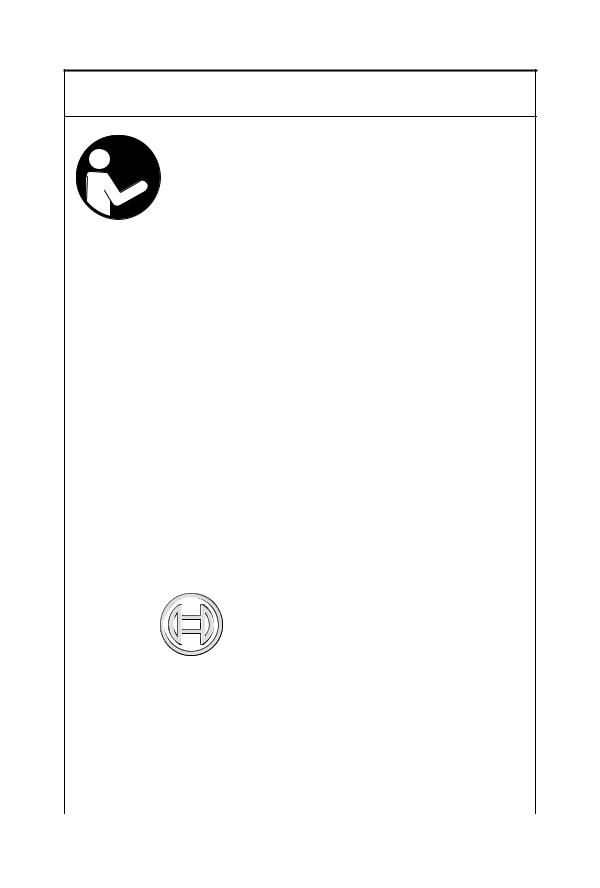
 BM 2610033301 10-13_BC630 10/11/13 10:52 AM Page 1
BM 2610033301 10-13_BC630 10/11/13 10:52 AM Page 1
IMPORTANT: |
IMPORTANT : |
IMPORTANTE: |
Read Before Using |
Lire avant usage |
Leer antes de usar |
|
|
|
Operating/Safety Instructions 
 Consignes de fonctionnement/sécurité
Consignes de fonctionnement/sécurité
Instrucciones de funcionamiento y seguridad
BC630
BC660
BC1836
|
Call Toll Free for |
Pour obtenir des informations |
Llame gratis para |
|
Consumer Information |
et les adresses de nos centres |
obtener información |
||
|
& Service Locations |
de service après-vente, |
para el consumidor y |
|
|
|
appelez ce numéro gratuit |
ubicaciones de servicio |
|
|
|
|
||
|
1-877-BOSCH99 (1-877-267-2499) www.boschtools.com |
|
||
|
|
|
|
|
For English Version |
Version française |
Versión en español |
||
|
See page 2 |
Voir page 6 |
Ver la página 10 |
|
|
|
|
|
|

 BM 2610033301 10-13_BC630 10/11/13 10:52 AM Page 2
BM 2610033301 10-13_BC630 10/11/13 10:52 AM Page 2
! WARNING |
Read and understand all instructions. Failure to follow all instructions |
|
listed below, may result in electric shock, fire and/or serious personal injury. |
|
IMPoRTANT SAFeTy AND oPeRATINg INSTRUCTIoNS |
|
“SAVe THeSe INSTRUCTIoNS” |
|
Charger Safety Rules |
1.This manual contains instructions for battery charger models BC630, BC660, & BC1836. Do not substitute any other charger.
2.Before using battery charger, read all instructions and cautionary markings on (1) battery charger, (2) battery pack, and (3) product using battery.
3.Charge only Bosch rechargeable batteries listed on page 5, 6 & 7. Other types of batteries may burst causing personal injury and damage.
4.Charge battery pack in temperatures above +32 degrees F (0 degrees C) and below +113 degrees F (45 degrees C). Store tool and battery pack in locations where temperatures will not exceed 120 degrees F (49 degrees C). This is important to prevent serious damage to the battery cells.
5.Do not recharge battery in damp or wet environment. Do not expose charger to rain or snow. Water entering battery charger may result in electric shock or fire.
6.Battery leakage may occur under extreme usage or temperature conditions. Avoid contact with skin and eyes. The battery liquid is caustic and could cause chemical burns to tissues. If liquid comes in contact with skin, wash quickly with soap and water. If the liquid contacts your eyes, flush them with water for a minimum of 10 minutes and seek medical attention.
7.Place charger on flat nonflammable surfaces and away from flammable materials when recharging battery pack.
Carpeting and other heat insulating surfaces block proper air circulation which may cause overheating of the charger and battery pack. If smoke or melting of the charger or battery pack is observed, unplug the charger immediately and do not use the battery pack or charger. Contact customer service immediately.
8.Make sure cord is located so that it will not be stepped on, tripped over, or otherwise subjected to damage or stress.
Damaged plug and cord may result in electric shock or fire.
9.Disconnect the charger by pulling the plug rather than the cord. Do not operate charger with damaged cord or plug; have them replaced immediately. Damaged plug or cord may result in electric shock or fire.
10.Do not insert battery pack in charger if battery pack case is cracked. Using damaged battery pack may result in electric shock or fire.
11.Do not disassemble charger or operate the charger if it has received a sharp blow, been dropped or otherwise damaged in anyway. Incorrect reassembly or damage may result in electric shock or fire.
12.Before each use, check the battery charger, cable and plug. If damage is detected, do not use the battery charger. Never open the battery charger yourself, take it to a Bosch Factory Service Center, or qualified serviceman only using original spare parts. Incorrect reassembly may result in electric shock or fire.
13.Do not use attachments not recommended or sold by Bosch. Using attachments not recommended may result in electric shock or fire.
14.Do not store battery pack in charger.
Battery pack stored in charger over a long period of time could lead to battery pack damage and fire.
15.Unplug charger from outlet before storage, attempting any maintenance or cleaning. Such preventive safety measures reduce the risk of electric shock or fire.
16.Keep the battery charger clean by blowing compressed air on charger vents and wiping the charger housing with a damp cloth. Contamination may result in electric shock or fire.
17.Replace battery pack if a substantial drop in operating time per charge is observed. Battery pack may be nearing the end of its life.
-2-
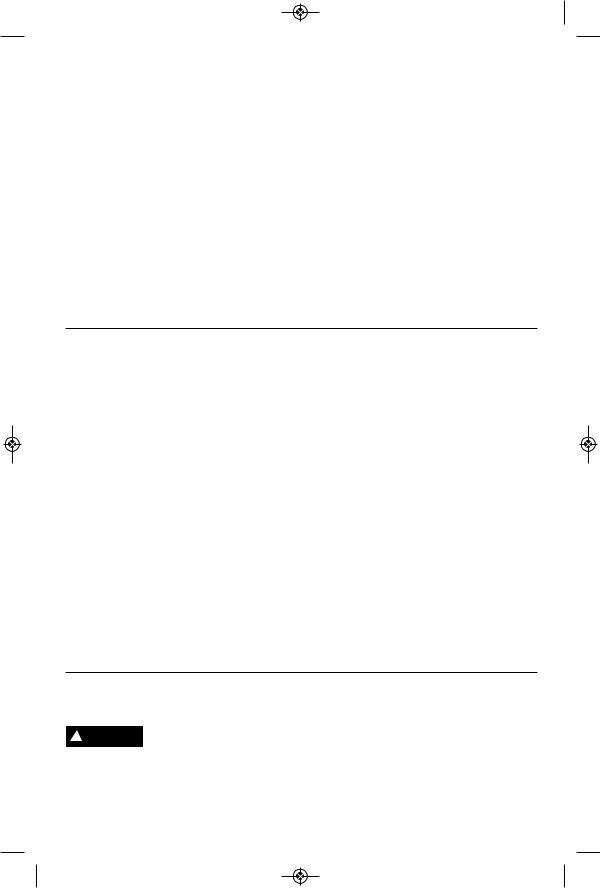
 BM 2610033301 10-13_BC630 10/11/13 10:52 AM Page 3
BM 2610033301 10-13_BC630 10/11/13 10:52 AM Page 3
Important Charging Notes
1.The charger was designed to fast charge the battery only when the battery temperature is between 32˚F (0˚C) and 113˚F (45˚C). If the battery pack is too hot or too cold, the charger will not fast charge the battery. (This may happen if the battery pack is hot from heavy use). When the battery temperature returns to between 32˚F (0˚C) and 113˚F (45˚C), the charger will automatically begin charging.
2.A substantial drop in operating time per charge may mean that the battery pack is nearing the end of its life and should be replaced.
3.Remember to unplug charger during storage period.
4.If battery does not charge properly:
a.Check for voltage at outlet by plugging in some other electrical device.
b.Check to see if outlet is connected to a light switch which turns power “off” when lights are turned off.
c.Check battery pack terminals for dirt. Clean with cotton swab and alcohol if necessary.
d.If you still do not get proper charging, take or send tool, battery pack and charger to your local Bosch Service Center. See “Tools, Electric” in the Yellow Pages for names and addresses.
Note: Use of chargers or battery packs not sold by Bosch will void the warranty.
FCC Caution:
The manufacturer is not responsible for radio interference caused by unauthorized modifications to this equipment. Such modifications could void the user’s authority to operate the equipment.
This device complies with Part 15 of the FCC Rules. Operation is subject to the following two conditions:
1)This device may not cause harmful interference, and
2)This device must accept any interference received, including interference that may cause undesired operation.
NoTe! This equipment has been tested and found to comply with the limits for a Class B digital devices, pursuant to Part 15 of the FCC rules. These limits are designed to provide reasonable protection against harmful interference in a residential installation. This equipment generates uses and can radiate
radio frequency energy and, if not installed and used in accordance with the instructions, may cause harmful interference to radio communications. However, there is no guarantee that interference will not occur in a particular installation. If this equipment does cause harmful interference to radio or television reception, which can be determined by turning the equipment off and on, the user is encouraged to try to correct the interference by one or more of the following measures:
•Reorient or relocate the receiving antenna.
•Increase the separation between the equipment and receiver.
•Connect the equipment into an outlet on a circuit different from that to which the receiver is connected.
•Consult the dealer or an experienced radio/TV technician for help.
Battery Care
When batteries are not in ! WARNING tool or charger, keep them
away from metal objects. For example, to protect terminals from shorting Do NoT place
batteries in a tool box or pocket with nails, screws, keys, etc. Fire or injury may result.
Do NoT PUT BATTeRIeS INTo FIRe oR exPoSe To HIgH HeAT. They may explode.
-3-
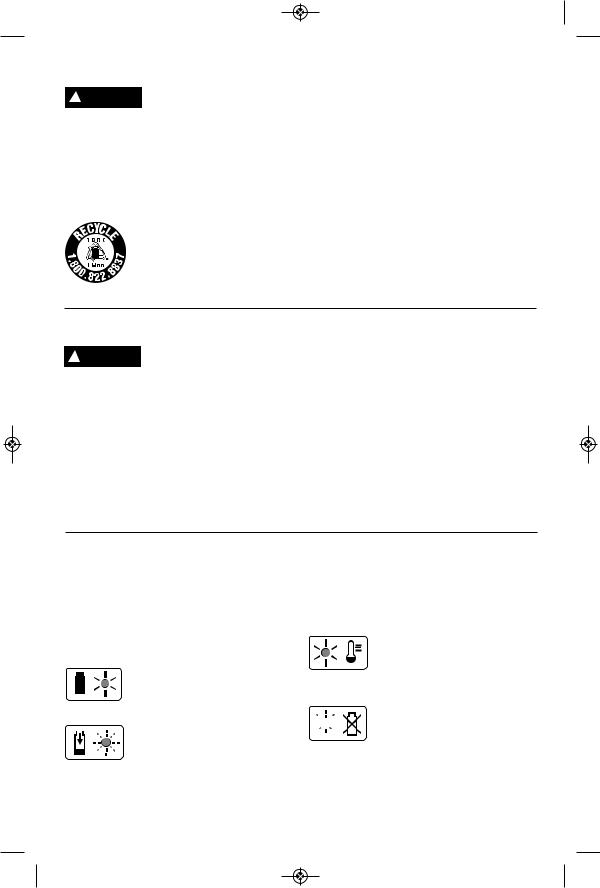
 BM 2610033301 10-13_BC630 10/11/13 10:52 AM Page 4
BM 2610033301 10-13_BC630 10/11/13 10:52 AM Page 4
Battery Disposal
Do not attempt to disas- ! WARNING semble the battery or
remove any com ponent projecting from the battery terminals. Fire or injury may result. Prior to disposal, protect exposed terminals with heavy insulating tape to prevent shorting.
Lithium-ion Batteries
industry program to collect and recycle these batteries at the end of their useful life, when taken out of service in the United States or Canada. The RBRC program provides a convenient alterative to placing used Li-ion batteries into the trash or the munici pal waste stream, which may be illegal in your area.
If equipped with a lithium-ion battery, the battery must be collected, recycled or disposed of in an environ mentally sound manner.
“The EPA certified RBRC Battery Recycling Seal on the lithium-ion (Li-ion) battery indicates Robert Bosch Tool Corporation is voluntarily participating in an
Please call 1-800-8-BATTERY for information on Li-ion battery recycling and disposal bans/restrictions in your area, or return your batteries to a Skil/Bosch/Dremel Service Center for recycling. Robert Bosch Tool Corporation’s involvement in this program is part of our commitment to preserving our environment and conserving our natural resources.”
extension Cords
AN exTeNSIoN CoRD ! WARNING SHoULD NoT Be USeD
UNLeSS ABSoLUTeLy NeCeSSARy. Use of improper extension cord could result in risk of fire and electrical shock. If an extension cord is used, make sure:
a.The pins on plug of extension cord are the same number, size, and shape as those of plug on charger.
b.The extension cord is properly wired and in good electrical condition.
c.The wire size is large enough for AC ampere rating of charger as specified below:
d. An extension cord is a temporary solution. Move the charger to a standard receptacle as soon as the job has been completed.
Length of |
25 |
50 |
100 |
|
150 |
|
Cord, Feet |
|
|||||
|
|
|
|
|
|
|
|
|
|
|
|
|
|
AWG Size |
18 |
16 |
16 |
|
14 |
|
of Cord |
|
|||||
|
|
|
|
|
|
|
|
|
|
|
|
|
|
Extension Cord Chart for 220/240 Volt Tools: |
||||||
0.75mm2 CORD |
|
|
50 Meters |
|
||
1.0mm2 CORD |
|
|
75 Meters |
|
||
operating Instructions
The battery is supplied partially charged. Completely charge the battery before using your cordless screwdriver for the first time. The lithium
ion battery can be charged at any time, without reducing its service life. Interrupting the charging procedure does not damage the battery.
Charger Indicators, symbols and meaning (model BC630)
If the indicator lights are “OFF”, the charger is not receiving power from power supply outlet.
If the green indicator light is “ON”, the charger is plugged in but the battery pack is not inserted, or the
battery pack is fully charged.
If the green indicator light is “BLINKING”, the battery pack is being fast-charged. Fast-charging
will automatically stop when the battery pack is fully charged.
If the red indicator light is “ON”, the battery pack is too hot or cold for fast-charging. The charger will
automatically switch to fast-charging once a suitable temperature is reached.
If the red indicator light is 


 “BLINKING”, the battery pack
“BLINKING”, the battery pack 

 cannot accept a charge or the contacts of the charger or battery pack are contaminated. Clean the contacts of the charger or battery pack only as directed in these operating instructions or those supplied with your tool or battery pack.
cannot accept a charge or the contacts of the charger or battery pack are contaminated. Clean the contacts of the charger or battery pack only as directed in these operating instructions or those supplied with your tool or battery pack.
-4-
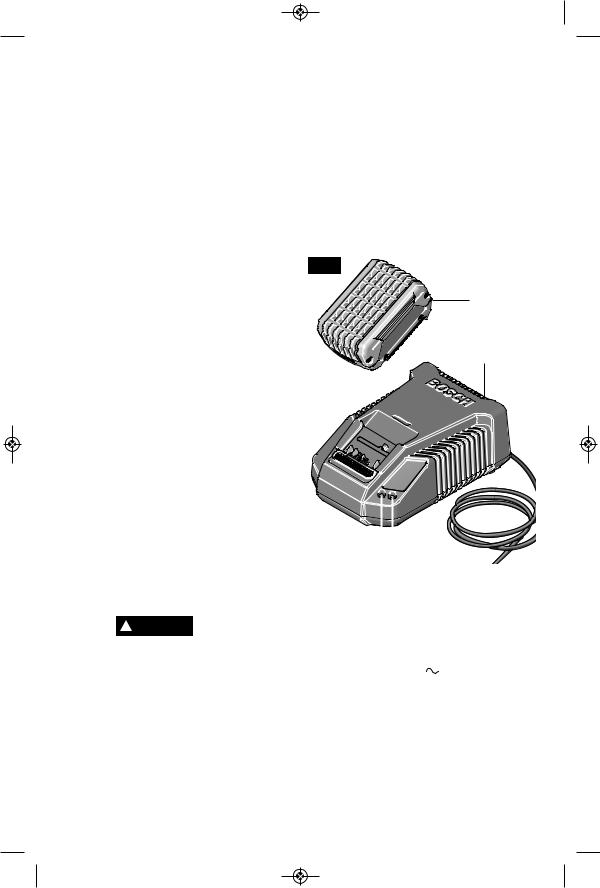
 BM 2610033301 10-13_BC630 10/11/13 10:52 AM Page 5
BM 2610033301 10-13_BC630 10/11/13 10:52 AM Page 5
Charging Battery Pack (model BC630)
Plug charger cord into your standard power outlet.
With no battery pack inserted, the charger’s green indicator light will go ON. This indicates the charger is receiving power and the charger is ready for operation.
When you insert the battery pack into the charger. The charger’s green indicator light will begin to “BLINK”. This indicates that the battery is receiving a fast charge (Fig. 1).
When the indicator light stops “BLINKING” (and becomes a steady green light) fast charging is complete. The battery pack is fully charged and can be removed from the charger.
The battery pack may be used even though the light may still be blinking. The light may require more time to stop blinking depending on temperature.
The purpose of the green light is to indicate that the battery pack is fast-charging. It does not indicate the exact point of full charge. The light will stop blinking in less time if the battery pack was not completely discharged.
When you begin the charging process of the battery pack, a steady red light could also mean the battery pack is too hot or too cold.
Fast charging is only possible when the temperature range of the battery pack is between 32˚F (0˚C) and 113˚F (45˚C). When needed, the internal fan of the charger will turn on to aid the charging process and speed.
As soon as the battery pack reaches the correct temperature range, the battery charger will automatically switch to fast charging.
If the red indicator light is “BLINKING”, the battery pack cannot accept a charge.
•Check to make sure the battery pack is inserted into the charger properly.
•Clean the contacts of the charger or battery pack (e. g. by inserting and removing the battery several times) or replace the battery pack, as required.
When the battery pack is fully charged, unplug the charger (unless you're charging another battery pack) and slip the battery pack back into the tool.
FIG. 1
BATTERY
PACK
CHARGER
RED LIGHT |
|
|
|
GREEN LIGHT |
|
|
|
! WARNING This charger will only charge the following batteries:
Battery packs |
Charger (model BC630) |
BAT610G through BAT625 |
Voltage rating 120 V 60 Hz |
Voltage rating 18V 


For most up to date battery compatibility, please refer to www.boschtools.com
“SAVe THeSe INSTRUCTIoNS”
-5-
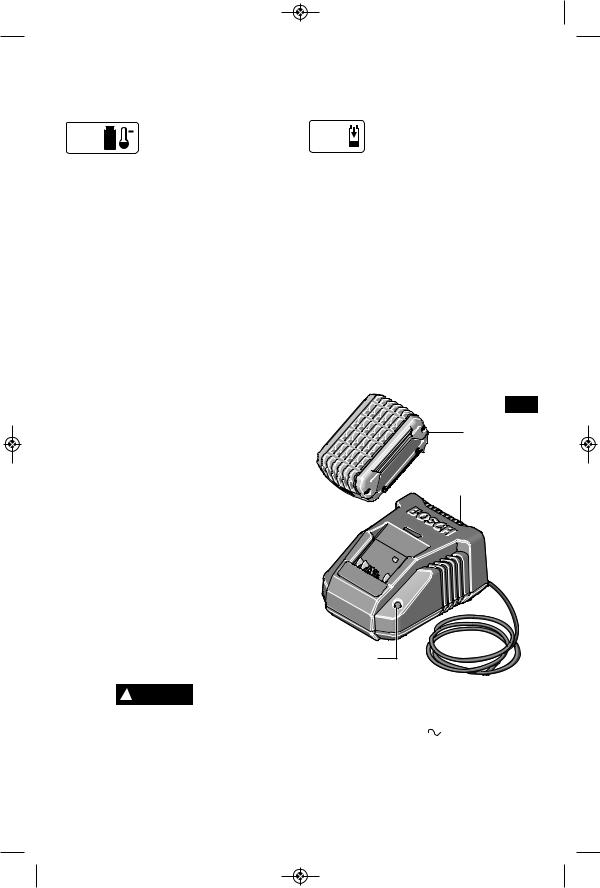
 BM 2610033301 10-13_BC630 10/11/13 10:52 AM Page 6
BM 2610033301 10-13_BC630 10/11/13 10:52 AM Page 6
Charger Indicators, symbols and meaning (model BC660)
If the indicator lights are “OFF”, the charger is not receiving power from power supply outlet.
If the green indicator light is

 “ON”, the charger is plugged in but the battery pack is not inserted, or the battery pack is fully charged, or
“ON”, the charger is plugged in but the battery pack is not inserted, or the battery pack is fully charged, or
the battery pack is too hot or cold for fastcharging. The charger will automatically switch
to fast-charging once a suitable temperature is reached.
If the green indicator light is 
 “BLINKING”, the battery pack is being fast-charged. Fast-charging will automatically stop when the battery pack is
“BLINKING”, the battery pack is being fast-charged. Fast-charging will automatically stop when the battery pack is
fully charged.
Charging Battery Pack (model BC660)
Plug charger cord into your standard power outlet.
With no battery pack inserted, the charger’s green indicator light will go ON. This indicates the charger is receiving power and the charger is ready for operation.
When you insert the battery pack into the charger, the charger’s green indicator light will begin to “BLINK”. This indicates that the battery is receiving a fast charge (Fig. 2).
When the indicator light stops “BLINKING” (and becomes a steady green light) fast charging is complete. The battery pack is fully charged and can be removed from the charger.
When you begin the charging process of the battery pack, a steady green light could also mean the battery pack is too hot or too cold.
Fast charging is only possible when the temperature range of the battery pack is between 32˚F (0˚C) and 113˚F (45˚C). When needed, the internal fan of the charger will turn on to aid the charging process and speed.
As soon as the battery pack reaches the correct temperature range, the battery charger will automatically switch to fast charging.
The battery pack may be used even though the light may still be blinking. The light may require more time to stop blinking depending on temperature.
The purpose of the green light is to indicate that the battery pack is fast-charging. It does not indicate the exact point of full charge. The light will stop blinking in less time if the battery pack was not completely discharged.
If the green indicator light is “ON”, the battery pack cannot accept a charge.
•Check to make sure the battery pack is inserted into the charger properly.
•Clean the contacts of the charger or battery pack (e. g. by inserting and removing the battery several times) or replace the battery pack, as required.
When the battery pack is fully charged, unplug the charger (unless you're charging another battery pack) and slip the battery pack back into the tool.
FIG. 2
BATTERY
PACK
CHARGER
GREEN LIGHT
! WARNING This charger will only charge the following batteries:
Battery packs |
Charger (model BC660) |
BAT610G through BAT625 |
Voltage rating 120 V 60 Hz |
Voltage rating 18V
For most up to date battery compatibility, please refer to www.boschtools.com
“SAVe THeSe INSTRUCTIoNS”
-6-
